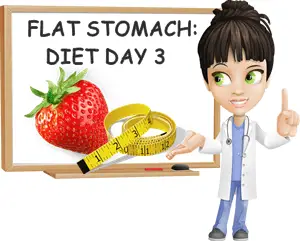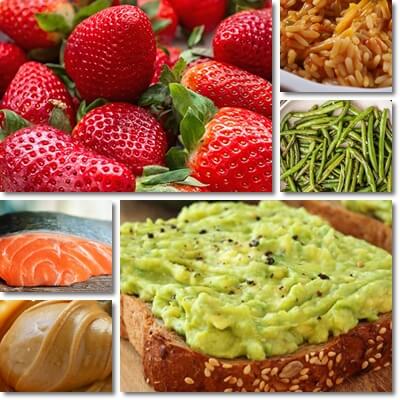The first step towards a flat stomach is losing excess weight. As you lose excess weight, your stomach starts to take on a flatter shape at which point it can successfully be toned via exercise to achieve a certain look, whether it’s visible muscle tone or 6-pack abs. To reach your goal of a flat stomach, your energy should first focus on your eating.
As any professional will tell you, weight loss rests 70% to 80% on your diet, that is, what you eat matters more than how much you exercise when it comes to losing excess weight. What you eat is just as important for your health too. So whether you are going for a flat stomach, or simply want to lose some excess weight to be healthier, take a look at my day 3 flat stomach diet plan below for inspiration on what to eat.
Also see my day 1 diet plan and day 2 diet plan for a flat stomach.

Day 3 flat stomach diet
Breakfast: avocado, toast and eggs
- Ingredients: 2 slices of toast (approximately 70 grams), 80 grams avocado (about 1 small avocado), 2 small soft boiled or poached eggs (estimated weight per egg: 50 grams)
- Calories (average values): 175 kcal (kilocalories) from the toast, 132 kcal from the avocado, 143 kcal from the egg for a total of 450 kcal
Avocado toast with eggs may seem like a very commercial option, but it’s actually a healthy, balanced and nutritious breakfast, not to mention tasty.
If you use whole grain bread, then you are getting 3 nutritionally dense foods for your first meal of the day without packing on the calories.
The bread represents the carbohydrate part of the meal and is in sufficient amounts to help with satiation as well as provide quick energy and mental satisfaction, whilst functioning as a satisfying base for the other foods. You can choose any bread you like, but if you go for whole grain it will help both curb hunger and keep you energized until your next meal as the complex carbohydrates in whole grains release energy gradually over the course of several hours.
Whole grain bread is also an excellent source of dietary fiber which both fills you up and regulates digestion for more regular and easy bowel movements. The serving of avocado also provides around 5.4 grams of dietary fiber which further helps you feel full and satisfied with the meal. Dietary fiber has the added benefit of lowering the glycemic impact of the meal which curbs hunger that often causes binge eating.

The avocado and eggs account for the fat portion of the meal: you are getting, on average, 11.7 grams of fat from the avocado and 10.6 grams of fat from the eggs. While it may seem like a lot when you see the numbers, it’s important to remember that the average adult can eat up to 78 grams of fat per day according to the new dietary guidelines, and that fat is an essential nutrient, needed in the diet for good health.
The fat from avocado is also wholly unprocessed while the fat from the eggs is only minimally processed through cooking. Fat is important in a diet as it’s responsible for satiation and helps with blood sugar control, curbing hunger and cravings and preventing sugar highs and lows and overeating.
Eggs are also a healthy choice because they are high protein and complete in all essential amino acids that the body absolutely needs every day. Protein is the third macronutrient needed to balance a meal for a feeling of long lasting satiety and no cravings, especially important in a weight loss diet.
Despite many people favoring egg whites for their high protein content, the yolk is actually higher in protein, except that the egg white is about 2/3 of the egg while the egg yolk is 1/3. However, egg yolk nutrition is better, although there are benefits to eating egg yolks as well as benefits to eating egg whites.
The eggs as well as the avocado are nutritionally dense foods, providing high amounts of most essential vitamins and minerals. Both eggs and avocado are high in B vitamins for elevated energy levels and vitality. The good content of potassium in avocado helps with blood pressure, while the phosphorus, vitamin D and selenium in eggs along with magnesium in avocado contribute to good bone density and strong bones and teeth, among other benefits for health.
Lunch: white rice with tomato sauce, basil and chickpeas
- Ingredients: 60 grams of white rice, 250 grams of tomato sauce or fresh tomatoes, 1 tablespoon of extravirgin olive oil, half a small onion, 50 grams of canned/cooked chickpeas (roasted), basil to taste
- Calories (average values): 210 kcal (kilocalories) from the rice, 50 kcal from the tomato sauce/tomatoes, 125 kcal from the olive oil, 20 kcal from the onion, 85 kcal from the chickpeas for a total of 490 kcal
How to make it:
Chop the onion finely and fry in one tablespoon of olive oil until golden. Add the tomato sauce or fresh tomatoes and cook for 5-10 minutes until reduced.
Add the rice and small amounts of water gradually, and stir continuously until the rice is cooked, but the grains still preserve their shape. Season with salt, ground pepper, basil, fresh or dried, and other spices or herbs you may like.
Separately, drain the chickpeas, season with salt, pepper, sweet or smoked paprika, and other spices you may like and roast in the oven on a baking sheet until golden-brown.
Top the rice with the chickpeas and either enjoy as is or pack it for lunch at work.
The rice accounts for the carbohydrate part of the meal and provides quick energy for the body to use. The fresh tomatoes or tomato sauce add small amounts of fiber, simple carbohydrates and sugars to the meal.
As a bonus, tomatoes provide carotenoids with benefits for skin, eyesight and cardiovascular health.
While the chickpeas account for the protein part of the meal with around 4.5 grams for the serving, they also provide good amounts of complex carbohydrates and dietary fiber to aid with satiation and digestion. The serving of chickpeas also add 1.3 grams of fat to the meal while the tablespoon of olive oil another 13 grams of fat, rounding up the macronutrient profile of the meal.
Snack:
- Option no. 1: 1 small banana (around 100 grams) with 10 grams of raw almonds/cashews/Brazil nuts (approximately 150 kcal)
- Option no. 2: 1 medium green apple (200 grams), raw or stewed in a little water with a sprinkle of cinnamon (approximately 120 kcal)
- Option no. 3: 300 grams fresh strawberries (approximately 100 kcal)
- Option no. 4: 1 tablespoon (25 grams) of peanut butter or almond butter or pistachio butter (approximately 150 kcal)
A snack is just as important for curbing hunger as it is for curbing cravings. While you do need to limit the number of calories and go for healthy options, do eat things you like.
Dinner: 200 g salmon, 200 g green beans, baked, with water, covered
- Ingredients: 200 grams of raw salmon, 200 grams green beans or string beans (fresh or frozen), spices and herbs (garlic powder, thyme, rosemary, oregano, smoked paprika, sweet paprika, salt, pepper)
- Calories (average values): 430 kcal from the salmon, 65 kcal from the green beans for a total of 495 kcal
How to make it:
Coat the salmon with ground pepper, garlic powder, a bit of smoked and sweet paprika, dried thyme, or other herbs and spices you may like, and a bit of salt. In an oven safe fish (I used glass), spread the beans on the bottom and top with the piece of raw salmon. Add a glass of water (careful not to wash away the spice coating on the salmon), cover the dish with foil making sure you wrap it tightly and bake on medium heat until the water is evaporated and the vegetables and fish are cooked.
In my case, it took 1 hour and 15 minutes for everything to cook, but cooking time may vary so make sure you keep a close eye on your dinner after the 45 minute mark. The salmon came out extremely tender, breaking off in piece at the slightest touch, and the beans complimented it wonderfully.
The salmon accounts for the protein and fat portion of the meal, while the green beans provide digestible carbohydrates and dietary fiber. You can always add a slice of bread to the meal, but honestly, it tastes perfectly as it is, and is quite satiating.
While salmon is an oily fish, that is, it’s not good to go to sleep right after eating it, it does help with satiety and is quite filling and satisfying. The green beans compliment it perfectly because they are lighter, and provide opposing nutrition. This is quite a refined, but easy meal, and nutritionally dense, all the while providing a limited number of calories.
